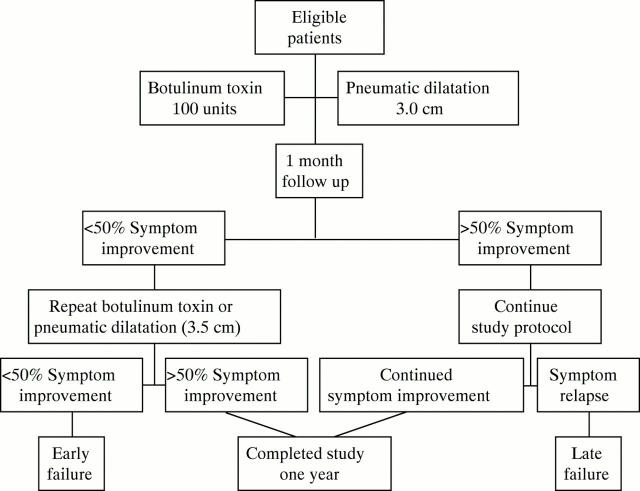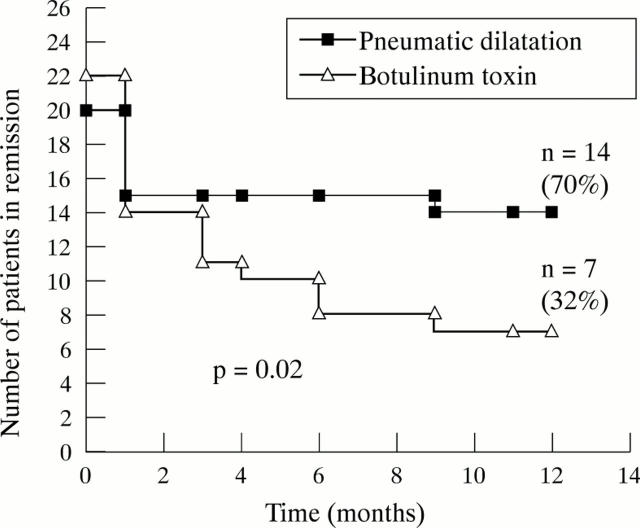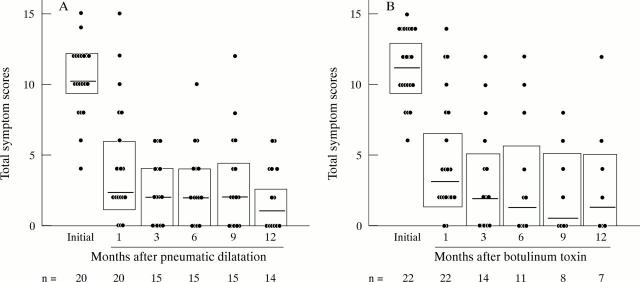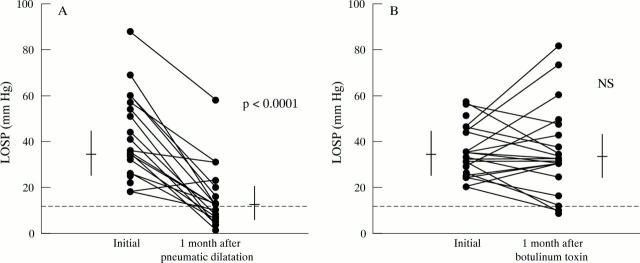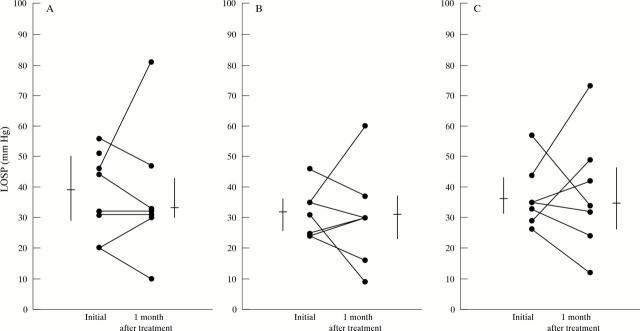Abstract
Background—Intrasphincteric injection of botulinum toxin is a new treatment option for achalasia. Aims—To compare the immediate and long term efficacy of botulinum toxin with that of pneumatic dilatation. Methods—Symptomatic patients with achalasia were randomised to botulinum toxin (22 patients, median age 57 years) or pneumatic dilatation (20 patients, median age 56 years). Symptom scores were assessed initially, and at one, three, six, nine, and 12months after treatment. Objective assessment included oesophageal manometry initially and at one month, and barium oesophagram initially and at one, six, and 12 months post-treatment. Results—Pneumatic dilatation resulted in a significantly (p=0.02) higher cumulative remission rate. At 12 months, 14/20 (70%) pneumatic dilatation and 7/22 (32%) botulinum toxin treated patients were in symptomatic remission (p=0.017). Failure rates were similar initially, but failure over time was significantly (p=0.01) higher after botulinum toxin (50%) than pneumatic dilatation (7%). Pneumatic dilatation resulted in significant (p<0.001) reduction in symptom scores, and lower oesophageal sphincter pressure, oesophageal barium column height, and oesophageal diameter. Botulinum toxin produced significant reduction in symptom scores (p<0.001), but no reduction in objective parameters. Conclusions—At one year pneumatic dilatation is more effective than botulinum toxin. Symptom improvement parallels objective oesophageal measurements after pneumatic dilatation but not after botulinum toxin treatment for achalasia.
Keywords: achalasia; pneumatic dilatation; botulinum toxin; barium oesophagram
Full Text
The Full Text of this article is available as a PDF (161.8 KB).
Figure 1 .
Schematic summary of the study protocol comparing pneumatic dilatation with botulinum toxin.
Figure 2 .
Kaplan-Meier plot showing significantly (p=0.02) higher cumulative one year remission rate for patients treated with pneumatic dilatation compared with botulinum toxin.
Figure 3 .
Patient symptom scores initially and at one, three, six, nine, and 12 months after pneumatic dilatation (A) and botulinum toxin treatment (B). The medians and interquartile ranges (25% to 75%) are shown with horizontal lines and boxed in rectangles, respectively. The number of patients (n) remaining in the study is shown for each time interval.
Figure 4 .
Lower oesophageal sphincter pressures (LOSP) initially and at one month after pneumatic dilatation (A) and botulinum toxin treatment (B). The horizontal lines denote group medians and the vertical bars represent interquartile ranges (25% to 75%). The dotted horizontal line represents a lower oesophageal sphincter pressure of 12 mm Hg.
Figure 5 .
Lower oesophageal sphincter pressures (LOSP) initially and at one month after botulinum toxin treatment in (A) early and (B) late failure groups as well as those in remission at (C) one year.
Figure 6 .
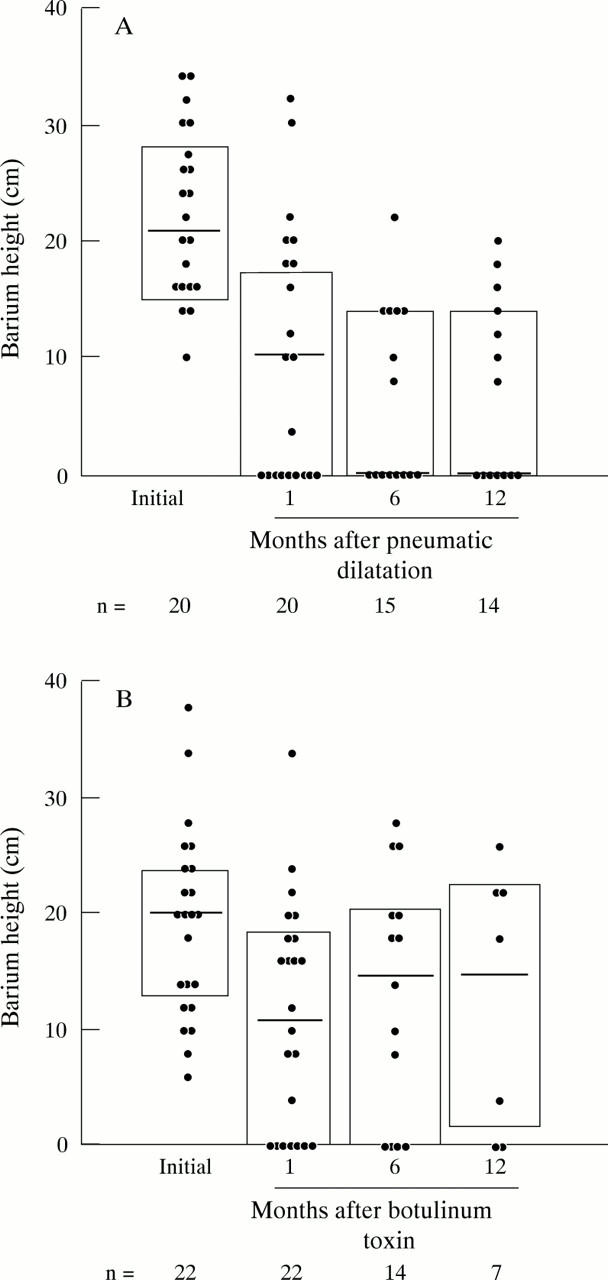
Oesophageal barium column height representing oesophageal emptying initially and at one, six, and 12 months after pneumatic dilatation (A) and botulinum toxin treatment (B). The horizontal lines denote group medians while the vertical bars represent interquartile ranges (25% to 75%). The number of patients (n) remaining in the study is shown for each time interval.
Figure 7 .
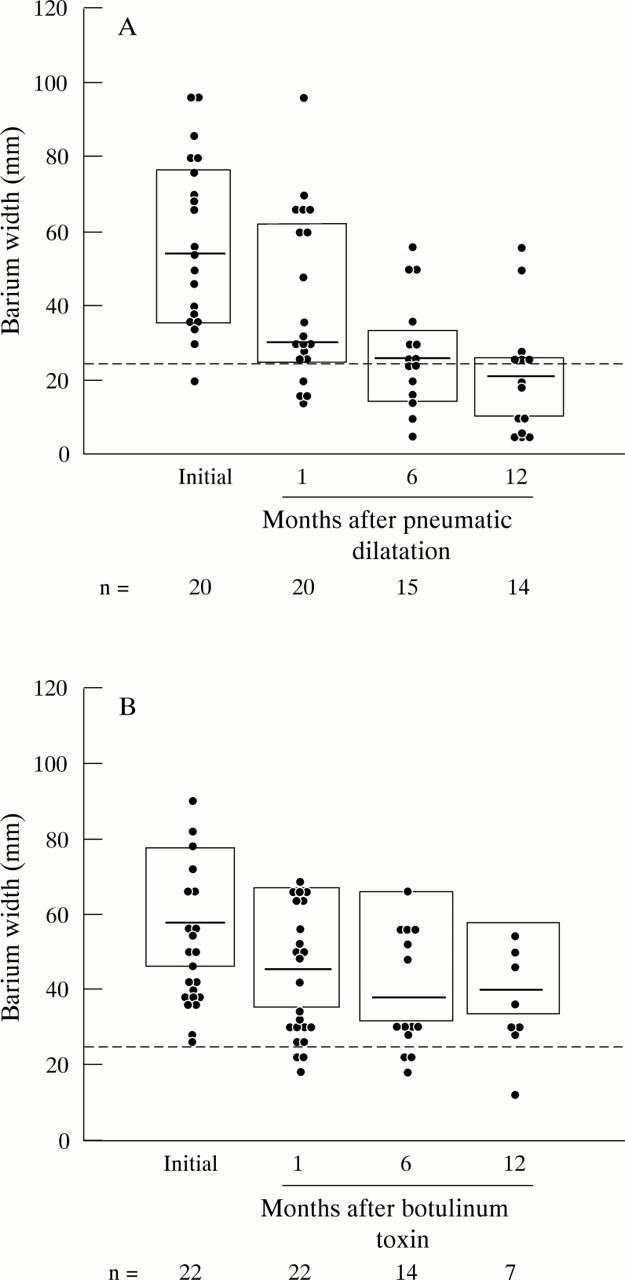
Barium width representing oesophageal diameter initially and at one, six, and 12 months after pneumatic dilatation (A) and botulinum toxin treatment (B). The horizontal lines denote group medians while the vertical bars represent interquartile ranges (25% to 75%). The number of patients (n) remaining in the study is shown for each time interval.
Selected References
These references are in PubMed. This may not be the complete list of references from this article.
- Abid S., Champion G., Richter J. E., McElvein R., Slaughter R. L., Koehler R. E. Treatment of achalasia: the best of both worlds. Am J Gastroenterol. 1994 Jul;89(7):979–985. [PubMed] [Google Scholar]
- Achkar E. Achalasia. Gastroenterologist. 1995 Dec;3(4):273–288. [PubMed] [Google Scholar]
- Annese V., Basciani M., Perri F., Lombardi G., Frusciante V., Simone P., Andriulli A., Vantrappen G. Controlled trial of botulinum toxin injection versus placebo and pneumatic dilation in achalasia. Gastroenterology. 1996 Dec;111(6):1418–1424. doi: 10.1016/s0016-5085(96)70002-1. [DOI] [PubMed] [Google Scholar]
- Birgisson S., Richter J. E. Achalasia: what's new in diagnosis and treatment? Dig Dis. 1997;15 (Suppl 1):1–27. doi: 10.1159/000171617. [DOI] [PubMed] [Google Scholar]
- Cuillière C., Ducrotté P., Zerbib F., Metman E. H., de Looze D., Guillemot F., Hudziak H., Lamouliatte H., Grimaud J. C., Ropert A. Achalasia: outcome of patients treated with intrasphincteric injection of botulinum toxin. Gut. 1997 Jul;41(1):87–92. doi: 10.1136/gut.41.1.87. [DOI] [PMC free article] [PubMed] [Google Scholar]
- Eckardt V. F., Aignherr C., Bernhard G. Predictors of outcome in patients with achalasia treated by pneumatic dilation. Gastroenterology. 1992 Dec;103(6):1732–1738. doi: 10.1016/0016-5085(92)91428-7. [DOI] [PubMed] [Google Scholar]
- Fishman V. M., Parkman H. P., Schiano T. D., Hills C., Dabezies M. A., Cohen S., Fisher R. S., Miller L. S. Symptomatic improvement in achalasia after botulinum toxin injection of the lower esophageal sphincter. Am J Gastroenterol. 1996 Sep;91(9):1724–1730. [PubMed] [Google Scholar]
- Gordon J. M., Eaker E. Y. Prospective study of esophageal botulinum toxin injection in high-risk achalasia patients. Am J Gastroenterol. 1997 Oct;92(10):1812–1817. [PubMed] [Google Scholar]
- Kadakia S. C., Wong R. K. Graded pneumatic dilation using Rigiflex achalasia dilators in patients with primary esophageal achalasia. Am J Gastroenterol. 1993 Jan;88(1):34–38. [PubMed] [Google Scholar]
- Mittal R. K., Balaban D. H. The esophagogastric junction. N Engl J Med. 1997 Mar 27;336(13):924–932. doi: 10.1056/NEJM199703273361306. [DOI] [PubMed] [Google Scholar]
- Pasricha P. J., Kalloo A. N. Recent advances in the treatment of achalasia. Gastrointest Endosc Clin N Am. 1997 Apr;7(2):191–206. [PubMed] [Google Scholar]
- Pasricha P. J., Rai R., Ravich W. J., Hendrix T. R., Kalloo A. N. Botulinum toxin for achalasia: long-term outcome and predictors of response. Gastroenterology. 1996 May;110(5):1410–1415. doi: 10.1053/gast.1996.v110.pm8613045. [DOI] [PubMed] [Google Scholar]
- Pasricha P. J., Ravich W. J., Hendrix T. R., Sostre S., Jones B., Kalloo A. N. Intrasphincteric botulinum toxin for the treatment of achalasia. N Engl J Med. 1995 Mar 23;332(12):774–778. doi: 10.1056/NEJM199503233321203. [DOI] [PubMed] [Google Scholar]
- Pasricha P. J., Ravich W. J., Hendrix T. R., Sostre S., Jones B., Kalloo A. N. Treatment of achalasia with intrasphincteric injection of botulinum toxin. A pilot trial. Ann Intern Med. 1994 Oct 15;121(8):590–591. doi: 10.7326/0003-4819-121-8-199410150-00006. [DOI] [PubMed] [Google Scholar]
- Pasricha P. J., Ravich W. J., Kalloo A. N. Effects of intrasphincteric botulinum toxin on the lower esophageal sphincter in piglets. Gastroenterology. 1993 Oct;105(4):1045–1049. doi: 10.1016/0016-5085(93)90947-b. [DOI] [PubMed] [Google Scholar]
- Schantz E. J., Johnson E. A. Properties and use of botulinum toxin and other microbial neurotoxins in medicine. Microbiol Rev. 1992 Mar;56(1):80–99. doi: 10.1128/mr.56.1.80-99.1992. [DOI] [PMC free article] [PubMed] [Google Scholar]
- Tsui J. K. Botulinum toxin as a therapeutic agent. Pharmacol Ther. 1996;72(1):13–24. doi: 10.1016/s0163-7258(96)00091-5. [DOI] [PubMed] [Google Scholar]
- de Oliveira J. M., Birgisson S., Doinoff C., Einstein D., Herts B., Davros W., Obuchowski N., Koehler R. E., Richter J., Baker M. E. Timed barium swallow: a simple technique for evaluating esophageal emptying in patients with achalasia. AJR Am J Roentgenol. 1997 Aug;169(2):473–479. doi: 10.2214/ajr.169.2.9242756. [DOI] [PubMed] [Google Scholar]
- de Oliveira J. M., Birgisson S., Doinoff C., Einstein D., Herts B., Davros W., Obuchowski N., Koehler R. E., Richter J., Baker M. E. Timed barium swallow: a simple technique for evaluating esophageal emptying in patients with achalasia. AJR Am J Roentgenol. 1997 Aug;169(2):473–479. doi: 10.2214/ajr.169.2.9242756. [DOI] [PubMed] [Google Scholar]



